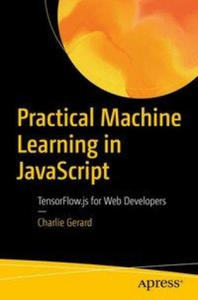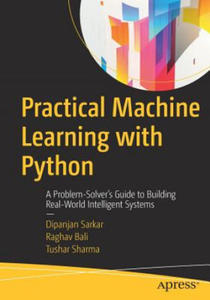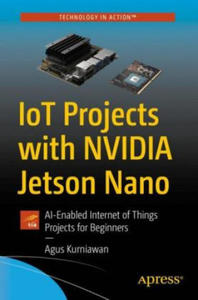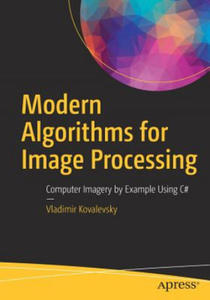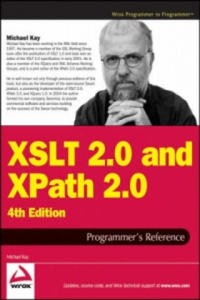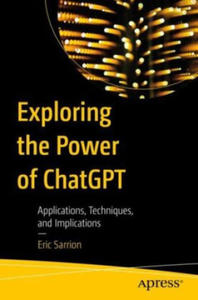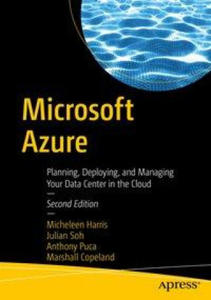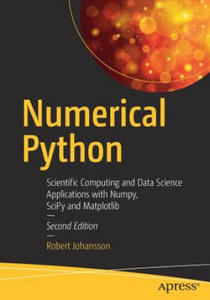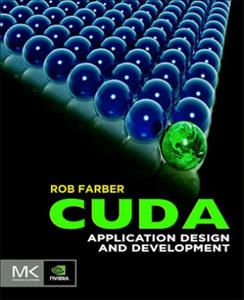libristo machine learning projects for net developers 5256819
- znaleziono 11 produktów w 1 sklepie
C# Machine Learning Projects Packt Publishing Limited
Książki / Literatura obcojęzyczna
This book equips you with all the information to build high-performing Machine Learning applications using C#. Through 10 enticing projects, you will implement various machine learning algorithms for a variety of real-world use-cases using popular libraries like Accord.NET, LiveCharts and Deedle, and start putting your skills to practical use.
Sklep: Libristo.pl
Practical Machine Learning in JavaScript APress
Książki / Literatura obcojęzyczna
Build machine learning web applications without having to learn a new language. This book will help you develop basic knowledge of machine learning concepts and applications. You'll learn not only theory, but also dive into code samples and example projects with TensorFlow.js. Using these skills and your knowledge as a web developer, you'll add a whole new field of development to your tool set. This will give you a more concrete understanding of the possibilities offered by machine learning. Discover how ML will impact the future of not just programming in general, but web development specifically. Machine learning is currently one of the most exciting technology fields with the potential to impact industries from health to home automation to retail, and even art. Google has now introduced TensorFlow.js-an iteration of TensorFlow aimed directly at web developers. Practical Machine Learning in JavaScript will help you stay relevant in the tech industry with new tools, trends, and best practices. What You'll Learn Use the JavaScript framework for ML Build machine learning applications for the web Develop dynamic and intelligent web content Who This Book Is For Web developers and who want a hands-on introduction to machine learning in JavaScript. A working knowledge of the JavaScript language is recommended.
Sklep: Libristo.pl
Practical Machine Learning with Python APress
Książki / Literatura obcojęzyczna
Master the essential skills needed to recognize and solve complex problems with machine learning and deep learning. Using real-world examples that leverage the popular Python machine learning ecosystem, this book is your perfect companion for learning the art and science of machine learning to become a successful practitioner. The concepts, techniques, tools, frameworks, and methodologies used in this book will teach you how to think, design, build, and execute machine learning systems and projects successfully.Practical Machine Learning with Python follows a structured and comprehensive three-tiered approach packed with hands-on examples and code.Part 1 focuses on understanding machine learning concepts and tools. This includes machine learning basics with a broad overview of algorithms, techniques, concepts and applications, followed by a tour of the entire Python machine learning ecosystem. Brief guides for useful machine learning tools, libraries and frameworks are also covered.Part 2 details standard machine learning pipelines, with an emphasis on data processing analysis, feature engineering, and modeling. You will learn how to process, wrangle, summarize and visualize data in its various forms. Feature engineering and selection methodologies will be covered in detail with real-world datasets followed by model building, tuning, interpretation and deployment.Part 3 explores multiple real-world case studies spanning diverse domains and industries like retail, transportation, movies, music, marketing, computer vision and finance. For each case study, you will learn the application of various machine learning techniques and methods. The hands-on examples will help you become familiar with state-of-the-art machine learning tools and techniques and understand what algorithms are best suited for any problem.Practical Machine Learning with Python will empower you to start solving your own problems with machine learning today! What You'll Learn Execute end-to-end machine learning projects and systemsImplement hands-on examples with industry standard, open source, robust machine learning tools and frameworksReview case studies depicting applications of machine learning and deep learning on diverse domains and industriesApply a wide range of machine learning models including regression, classification, and clustering.Understand and apply the latest models and methodologies from deep learning including CNNs, RNNs, LSTMs and transfer learning. Who This Book Is For IT professionals, analysts, developers, data scientists, engineers, graduate students
Sklep: Libristo.pl
Practical Machine Learning and Image Processing APress
Książki / Literatura obcojęzyczna
Gain insights into image-processing methodologies and algorithms, using machine learning and neural networks in Python. This book begins with the environment setup, understanding basic image-processing terminology, and exploring Python concepts that will be useful for implementing the algorithms discussed in the book. You will then cover all the core image processing algorithms in detail before moving onto the biggest computer vision library: OpenCV. You'll see the OpenCV algorithms and how to use them for image processing. The next section looks at advanced machine learning and deep learning methods for image processing and classification. You'll work with concepts such as pulse coupled neural networks, AdaBoost, XG boost, and convolutional neural networks for image-specific applications. Later you'll explore how models are made in real time and then deployed using various DevOps tools. All the concepts in Practical Machine Learning and Image Processing are explained using real-life scenarios. After reading this book you will be able to apply image processing techniques and make machine learning models for customized application. What You Will Learn Discover image-processing algorithms and their applications using PythonExplore image processing using the OpenCV libraryUse TensorFlow, scikit-learn, NumPy, and other librariesWork with machine learning and deep learning algorithms for image processingApply image-processing techniques to five real-time projects Who This Book Is For Data scientists and software developers interested in image processing and computer vision.
Sklep: Libristo.pl
IoT Projects with NVIDIA Jetson Nano APress
Książki / Literatura obcojęzyczna
Explore the capabilities of the NVIDIA Jetson Nano, an IoT device designed to perform computations like a computer desktop. This book will show you how to build your first project and optimize your devices, programs, and daily activities with the AI computation abilities of the Jetson Nano. This board consists of CPU Quad-core ARM A57 @ 1.43 GHz and GPU 128-core Maxwell. With this hardware specification, the board can run multiple neural networks in parallel for complex AI applications. With the integrated sensor and actuators, this board enables stronger IoT solutions and provides more advanced capabilities. Discover how develop complex IoT projects with the Jetson Nano today. What You'll Learn Set up NVIDIA Jetson Nano device Build applications like image classification, object detection, segmentation, and speech processing Use the Jetson Nano to process daily computer activities such as browsing the internet, checking emails, or playing music and videos Implement machine learning computations into your projects Who This Book Is For Makers, developers, students, and professional of all levels who are new to the NVIDIA Jetson Nano technology.
Sklep: Libristo.pl
Modern Algorithms for Image Processing APress
Książki / Literatura obcojęzyczna
Utilize modern methods for digital image processing and take advantage of the many time-saving templates provided for all of the projects in this book.Modern Algorithms for Image Processing approaches the topic of image processing through teaching by example. Throughout the book, you will create projects that resolve typical problems that you might encounter in the world of digital image processing. Some projects teach you methods for addressing the quality of images, such as reducing random errors or noise and suppressing pulse noise (salt and pepper), a method valuable for improving the quality of historical images. Other methods detail how to correct inhomogeneous illumination, not by means of subtracting the mean illumination, but through division, a far more efficient method. Additional projects cover contrasting, and a process for edge detection, more efficient than Canny's, for detecting edges in color images directly, without converting them into black and white images.What You'll LearnApply innovative methods for suppressing pulse noise, enhancing contrast, and edge detectionKnow the pros and cons of enlisting a particular methodUse new approaches for image compression and recognizing circles in photosUtilize a valuable method for straightening photos of paintings taken at an oblique angle, a critical concept to understand when using flash at a right angleUnderstand the problem statement of polygonal approximation of boundaries or edges and its solutionUse a new method for detecting bicycles in trafficAccess complete source code examples in C# for all of the projects Who This Book Is ForC# developers who work with digital image processing or are interested in informatics. The reader should have programming experience and access to an integrated development environment (IDE), ideally .NET.This book does not prove or disprove theorems, but suggests methods for learning valuable concepts that will enable you to customize your own image processing projects.
Sklep: Libristo.pl
XSLT 2.0 and XPath 2.0 Programmer's Reference 4e John Wiley & Sons Inc
Książki / Literatura obcojęzyczna
This book is primarily a practical reference book for professional XSLT developers. It assumes no previous knowledge of the language, and many developers have used it as their first introduction to XSLT; however, it is not structured as a tutorial, and there are other books on XSLT that provide a gentler approach for beginners. The book does assume a basic knowledge of XML, HTML, and the architecture of the Web, and it is written for experienced programmers. There's no assumption that you know any particular language such as Java or Visual Basic, just that you recognize the concepts that all programming languages have in common. The book is suitable both for XSLT 1.0 users upgrading to XSLT 2.0, and for newcomers to XSLT. The book is also equally suitable whether you work in the Java or .NET world. As befits a reference book, a key aim is that the coverage should be comprehensive and authoritative. It is designed to give you all the details, not just an overview of the 20 percent of the language that most people use 80 percent of the time.It's designed so that you will keep coming back to the book whenever you encounter new and challenging programming tasks, not as a book that you skim quickly and then leave on the shelf. If you like detail, you will enjoy this book; if not, you probably won't. But as well as giving the detail, this book aims to explain the concepts, in some depth. It's therefore a book for people who not only want to use the language but who also want to understand it at a deep level. The book aims to tell you everything you need to know about the XSLT 2.0 language. It gives equal weight to the things that are new in XSLT 2.0 and the things that were already present in version 1.0. The book is about the language, not about specific products. However, there are appendices about Saxon (the author's own implementation of XSLT 2.0), about the Altova XSLT 2.0 implementation, and about the Java and Microsoft APIs for controlling XSLT transformations, which will no doubt be upgraded to handle XSLT 2.0 as well as 1.0. A third XSLT 2.0 processor, Gestalt, was released shortly before the book went to press, too late to describe it in any detail. But the experience of XSLT 1.0 is that there has been a very high level of interoperability between different XSLT processors, and if you can use one of them, then you can use them all.In the previous edition we split XSLT 2.0 and XPath 2.0 into separate volumes. The idea was that some readers might be interested in XPath alone. However, many bought the XSLT 2.0 book without its XPath companion and were left confused as a result; so this time, the material is back together. The XPath reference information is in self-contained chapters, so it should still be accessible when you use XPath in contexts other than XSLT. The book does not cover XSL Formatting Objects, a big subject in its own right. Nor does it cover XML Schemas in any detail. If you want to use these important technologies in conjunction with XSLT, there are other books that do them justice. This book contains twenty chapters and eight appendixes (the last of which is a glossary) organized into four parts. The following section outlines what you can find in each part, chapter, and appendix. Part I: Foundations: The first part of the book covers essential concepts. You should read these before you start coding.If you ignore this advice, as most people do, then you read them when you get to that trough of despair when you find it impossible to make the language do anything but the most trivial tasks. XSLT is different from other languages, and to make it work for you, you need to understand how it was designed to be used. Chapter 1: XSLT in Context: This chapter explains how XSLT fits into the big picture: how the language came into being and how it sits alongside other technologies. It also has a few simple coding examples to keep you alert. Chapter 2: The XSLT Processing Model: This is about the architecture of an XSLT processor: the inputs, the outputs, and the data model. Understanding the data model is perhaps the most important thing that distinguishes an XSLT expert from an amateur; it may seem like information that you can't use immediately, but it's knowledge that will stop you making a lot of stupid mistakes. Chapter 3: Stylesheet Structure: XSLT development is about writing stylesheets, and this chapter takes a bird's eye view of what stylesheets look like.It explains the key concepts of rule-based programming using templates, and explains how to undertake programming-in-the-large by structuring your application using modules and pipelines. Chapter 4: Stylesheets and Schemas: A key innovation in XSLT 2.0 is that stylesheets can take advantage of knowledge about the structure of your input and output documents, provided in the form of an XML Schema. This chapter provides a quick overview of XML Schema to describe its impact on XSLT development. Not everyone uses schemas, and you can skip this chapter if you fall into that category. Chapter 5: The Type System: XPath 2.0 and XSLT 2.0 offer strong typing as an alternative to the weak typing approach of the 1.0 languages. This means that you can declare the types of your variables, functions, and parameters, and use this information to get early warning of programming errors. This chapter explains the data types available and the mechanisms for creating user-defined types. Part II: XSLT and XPath Reference: This section of the book contains reference material, organized in the hope that you can easily find what you need when you need it.It's not designed for sequential reading, though you might well want to leaf through the pages to discover what's there. Chapter 6: XSLT Elements: This monster chapter lists all the XSLT elements you can use in a stylesheet, in alphabetical order, giving detailed rules for the syntax and semantics of each element, advice on usage, and examples. This is probably the part of the book you will use most frequently as you become an expert XSLT user. It's a "no stone unturned" approach, based on the belief that as a professional developer you need to know what happens when the going gets tough, not just when the wind is in your direction. Chapter 7: XPath Fundamentals: This chapter explains the basics of XPath: the low-level constructs such as literals, variables, and function calls. It also explains the context rules, which describe how the evaluation of XPath expressions depends on the XSLT processing context in which they appear. Chapter 8: XPath: Operators on Items: XPath offers the usual range of operators for performing arithmetic, boolean comparison, and the like.However, these don't always behave exactly as you would expect, so it's worth reading this chapter to see what's available and how it differs from the last language that you used. Chapter 9: XPath: Path Expressions: Path expressions are what make XPath special; they enable you to navigate around the structure of an XML document. This chapter explains the syntax of path expressions, the 13 axes that you can use to locate the nodes that you need, and associated operators such as union, intersection, and difference. Chapter 10: XPath: Sequence Expressions: Unlike XPath 1.0, in version 2.0 all values are sequences (singletons are just a special case). Some of the most important operators in XPath 2.0 are those that manipulate sequences, notably the "for" expression, which translates one sequence into another by applying a mapping. Chapter 11: XPath: Type Expressions: The type system was explained in Chapter 5; this chapter explains the operations that you can use to take advantage of types. This includes the "cast" operation which is used to convert values from one type to another.A big part of this chapter is devoted to the detailed rules for how these conversions are done.Chapter 12: XSLT Patterns: This chapter returns from XPath to a subject that's specific to XSLT. Patterns are used to define template rules, the essence of XSLT's rule-based programming approach. The reason for explaining them now is that the syntax and semantics of patterns depends strongly on the corresponding rules for XPath expressions. Chapter 13: The Function Library: XPath 2.0 includes a library of functions that can be called from any XPath expression; XSLT 2.0 extends this with some additional functions that are available only when XPath is used within XSLT. The library has grown immensely since XPath 1.0. This chapter provides a single alphabetical reference for all these functions. Chapter 14: Regular Expressions: Processing of text is an area where XSLT 2.0 and XPath 2.0 are much more powerful than version 1.0, and this is largely through the use of constructs that exploit regular expressions. If you're familiar with regexes from languages such as Perl, this chapter tells you how XPath regular expressions differ. If you're new to the subject, it explains it from first principles.Chapter 15: Serialization: Serialization in XSLT means the ability to generate a textual XML document from the tree structure that's manipulated by a stylesheet. This isn't part of XSLT processing proper, so (following W3C's lead) it's separated it into its own chapter. You can control serialization from the stylesheet using an declaration, but many products also allow you to control it directly via an API. Part III: Exploitation: The final section of the book is advice and guidance on how to take advantage of XSLT to write real applications. It's intended to make you not just a competent XSLT coder, but a competent designer too. The best way of learning is by studying the work of others, so the emphasis here is on practical case studies. Chapter 16: Extensibility: This chapter describes the "hooks" provided in the XSLT specification to allow vendors and users to plug in extra functionality. The way this works will vary from one implementation to another, so we can't cover all possibilities, but one important aspect that the chapter does cover is how to use such extensions and still keep your code portable.Chapter 17: Stylesheet Design Patterns: This chapter explores a number of design and coding patterns for XSLT programming, starting with the simplest "fill-in-the-blanks" stylesheet, and extending to the full use of recursive programming in the functional programming style, which is needed to tackle problems of any computational complexity. This provides an opportunity to explain the thinking behind functional programming and the change in mindset needed to take full advantage of this style of development. Chapter 18: Case Study: XMLSpec: XSLT is often used for rendering documents, so where better to look for a case study than the stylesheets used by the W3C to render the XML and XSLT specifications, and others in the same family, for display on the web? The resulting stylesheets are typical of those you will find in any publishing organization that uses XML to develop a series of documents with a compatible look-and-feel. Chapter 19: Case Study: A Family Tree: Displaying a family tree is another typical XSLT application.This example with semi-structured data-a mixture of fairly complex data and narrative text-that can be presented in many different ways for different audiences. It also shows how to tackle another typical XSLT problem, conversion of the data into XML from a legacy text-based format. As it happens, this uses nearly all the important new XSLT 2.0 features in one short stylesheet. But another aim of this chapter is to show a collection of stylesheets doing different jobs as part of a complete application. Chapter 20: Case Study: Knight's Tour: Finding a route around a chessboard where a knight visits every square without ever retracing its steps might sound a fairly esoteric application for XSLT, but it's a good way of showing how even the most complex of algorithms are within the capabilities of the language. You may not need to tackle this particular problem, but if you want to construct an SVG diagram showing progress against your project plan, then the problems won't be that dissimilar. Part IV: Appendices: A ppendix A: XPath 2.0 Syntax Summary: Collects the XPath grammar rules and operator precedences into one place for ease of reference.Appendix B: Error Codes: A list of all the error codes defined in the XSLT and XPath language specifications, with brief explanations to help you understand what's gone wrong. Appendix C: Backward Compatibility: The list of things you need to look out for when converting applications from XSLT 1.0. Appendix D: Microsoft XSLT Processors: Although the two Microsoft XSLT processors don't yet support XSLT 2.0, we thought many readers would find it useful to have a quick summary here of the main objects and methods used in their APIs. Appendix E: JAXP: the Java API for XML Processing: JAXP is an interface rather than a product. Again, it doesn't have explicit support yet for XSLT 2.0, but Java programmers will often be using it in XSLT 2.0 projects, so the book includes an overview of the classes and methods available. Appendix F: Saxon: At the time of writing Saxon (developed by the author of this book) provides the most comprehensive implementation of XSLT 2.0 and XPath 2.0, so its interfaces and extensions are covered in some detail. Appendix G: Altova: Altova, the developers of XML Spy, have an XSLT 2.0 processor that can be used either as part of the development environment or as a freestanding component.This appendix gives details of its interfaces. Appendix H: Glossary Note: CD-ROM/DVD and other supplementary materials are not included as part of eBook file.
Sklep: Libristo.pl
Exploring the Power of ChatGPT Springer, Berlin
Książki / Literatura obcojęzyczna
Learn how to use the large-scale natural language processing model developed by OpenAI: ChatGPT. This book explains how ChatGPT uses machine learning to autonomously generate text based on user input and explores the significant implications for human communication and interaction.Author Eric Sarrion examines various aspects of ChatGPT, including its internal workings, use in computer projects, and impact on employment and society. He also addresses long-term perspectives for ChatGPT, including possible future advancements, adoption challenges, and considerations for ethical and responsible use. The book starts with an introduction to ChatGPT covering its versions, applications areas, how it works with neural networks, NLP, and its advantages and limitations. Next, you'll be introduced to applications and training development projects using ChatGPT, as well as best practices for it. You'll then explore the ethical implications of ChatGPT, such as potential biases and risks, regulations, and standards. This is followed by a discussion of future prospects for ChatGPT. The book concludes with practical use case examples, such as text content creation, software programming, and innovation and creativity.This essential book summarizes what may be one of the most significant developments in artificial intelligence in recent history and provides useful insights for researchers, policymakers, and anyone interested in the future of technology.What You Will LearnUnderstand the basics of deep learning and text generation using language models such as ChatGPTPrepare data and train a language model to generate textUse ChatGPT for various applications such as marketing text generation or answering questionsUnderstand the use of ChatGPT through the OpenAI API and how to optimize model performanceWho This Book Is ForSoftware developers and professionals, researchers, students, and people interested in learning more about this field and the future of technology.
Sklep: Libristo.pl
Microsoft Azure APress
Książki / Literatura obcojęzyczna
Gain the technical and business insight needed to plan, deploy, and manage the services provided by the Microsoft Azure cloud. This second edition focuses on improving operational decision tipping points for the professionals leading DevOps and security teams. This will allow you to make an informed decision concerning the workloads appropriate for your growing business in the Azure public cloud. Microsoft Azure starts with an introduction to Azure along with an overview of its architecture services such as IaaS and PaaS. You'll also take a look into Azure's data, artificial intelligence, and machine learning services. Moving on, you will cover the planning for and adoption of Azure where you will go through budgeting, cloud economics, and designing a hybrid data center. Along the way, you will work with web apps, network PaaS, virtual machines, and much more. The final section of the book starts with Azure data services and big data with an in-depth discussion of Azure SQL Database, CosmosDB, Azure Data Lakes, and MySQL. You will further see how to migrate on-premises databases to Azure and use data engineering. Next, you will discover the various Azure services for application developers, including Azure DevOps and ASP.NET web apps. Finally, you will go through the machine learning and AI tools in Azure, including Azure Cognitive Services. What You Will Learn Apply design guidance and best practices using Microsoft Azure to achieve business growth Create and manage virtual machines Work with AI frameworks to process and analyze data to support business decisions and increase revenue Deploy, publish, and monitor a web app Who This Book Is For Azure architects and business professionals looking for Azure deployment and implementation advice.
Sklep: Libristo.pl
Numerical Python APress
Książki / Literatura obcojęzyczna
Leverage the numerical and mathematical modules in Python and its standard library as well as popular open source numerical Python packages like NumPy, SciPy, FiPy, matplotlib and more. This fully revised edition, updated with the latest details of each package and changes to Jupyter projects, demonstrates how to numerically compute solutions and mathematically model applications in big data, cloud computing, financial engineering, business management and more.Numerical Python, Second Edition , presents many brand-new case study examples of applications in data science and statistics using Python, along with extensions to many previous examples. Each of these demonstrates the power of Python for rapid development and exploratory computing due to its simple and high-level syntax and multiple options for data analysis.After reading this book, readers will be familiar with many computing techniques including array-based and symbolic computing, visualization and numerical file I/O, equation solving, optimization, interpolation and integration, and domain-specific computational problems, such as differential equation solving, data analysis, statistical modeling and machine learning.W hat You'll LearnWork with vectors and matrices using NumPyPlot and visualize data with MatplotlibPerform data analysis tasks with Pandas and SciPyReview statistical modeling and machine learning with statsmodels and scikit-learnOptimize Python code using Numba and Cython Who This Book Is For Developers who want to understand how to use Python and its related ecosystem for numerical computing.
Sklep: Libristo.pl
CUDA Application Design and Development Elsevier Books
Książki / Literatura obcojęzyczna
As the computer industry retools to leverage massively parallel graphics processing units (GPUs), this book is designed to meet the needs of working software developers who need to understand GPU programming with CUDA and increase efficiency in their projects. "CUDA Application Design and Development" starts with an introduction to parallel computing concepts for readers with no previous parallel experience, and focuses on issues of immediate importance to working software developers: achieving high performance, maintaining competitiveness, analyzing CUDA benefits versus costs, and determining application lifespan. This book then details the thought behind CUDA and teaches how to create, analyze, and debug CUDA applications. Throughout, the focus is on software engineering issues: how to use CUDA in the context of existing application code, with existing compilers, languages, software tools, and industry-standard API libraries. Using an approach refined in a series of well-received articles at "Dr Dobb's Journal", author Rob Farber takes the reader step-by-step from fundamentals to implementation, moving from language theory to practical coding.Thsi title includes multiple examples building from simple to more complex applications in four key areas: machine learning, visualization, vision recognition, and mobile computing. It addresses the foundational issues for CUDA development: multi-threaded programming and the different memory hierarchy. It includes teaching chapters designed to give a full understanding of CUDA tools, techniques and structure. It presents CUDA techniques in the context of the hardware they are implemented on as well as other styles of programming that will help readers bridge into the new material.
Sklep: Libristo.pl
Sklepy zlokalizowane w miastach: Warszawa, Kraków, Łódź, Wrocław, Poznań, Gdańsk, Szczecin, Bydgoszcz, Lublin, Katowice
Szukaj w sklepach lub całym serwisie
1. Sklepy z libristo pl machine learning projects for net developers 5256819
2. Szukaj na wszystkich stronach serwisu
t1=0.038, t2=0, t3=0, t4=0, t=0.038


